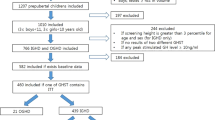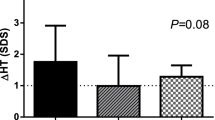Abstract
Growth hormone (GH) secretion was determined by evaluating ultradian GH profiles for 12 h and GH responses to insulin stimulated hypoglycaemia (ITT) in 28 stunted boys with β-thalassaemia major aged 15.2–17.4 years, who presented with pubertal failure (FP). Healthy non thalassaemia prepubertal boys (n=10) aged 7.5–8.8 years, were studied as controls. All patients had normal responses to ITT with peak GH levels ≥15 mU/l. Basal GH concentrations (mean±sem) (1.65±0.03 mU/l vs 2.58±0.27 mU/l;P<0.05) and the stimulated GH responses (peak GH=15.4±0.20 mU/l vs 21.08±0.78 mU/l;P<0.001) were significantly lower in the patients with failed puberty than in the controls, indicating that the FP patients had diminished GH reserve and secretory capacity. Moreover, all the GH peak parameters including the maximum spontaneous concentrations (MX-GH) and the area under the GH curve (AUC) were significantly lower in the thalassaemic patients than in the controls (MX-GH=5.2±0.21 mU/l vs 20.42±0.14 mU/l;P<0.001; AUCb=421.22±4.31 mU/l vs 712.20±3.42 mU/l;P<0.001). These observations suggest that the thalassaemic patients had endogenous neurosecretory GH deficiency (GHND). Priming with sex steroid did not cause any improvement in the spontaneous or stimulated GH secretory patterns in thalassaemic patients. It was noteworthy that in neither the patients nor the control subjects, was there a significant correlation between the maximum stimulated and the MX-GH concentrations. These data suggest that the provocative ITT underestimates spontaneous GH secretion and that measurement of spontaneous GH secretion was a more reliable method for identifying patients with GH insufficiency than the ITT.
Similar content being viewed by others
Abbreviations
- AMPL:
-
residual amplitude
- AUC:
-
area under the curve
- AUCb:
-
area above calculated baseline
- FP:
-
pubertal failure
- GH:
-
growth hormone
- GHND:
-
neurosecretory growth hormone deficiency
- IC-GH:
-
integrated growth hormone
- IPI:
-
interval between two peaks
- ITT:
-
insulin stimulated hypoglycaemia
- MX-GH:
-
maximum spontaneous growth hormone
- PL:
-
residual length
References
Albertsson-Wikland K, Rosberg S (1988). Analyses of 24-hour growth hormone profiles in children: relation to growth. J Clinical Endocrinol Metab 67:493–500
Aynsley-Green A, Zachman M, Prader A (1976) Interrelation of the therapeutic effects of growth hormone and testosterone on growth in hypotituitarism. J Pediatr 89:992–999
Arimura A, Culler MD (1985) Regulation of growth hormone secretion. In: Imura H (ed) The pituitary gland. Raven Press, New York, p 221–232
Bercu BB (1985) Patterns of pulsatile growth hormone secretion in children. In: Crowley WF, Hofler JG (eds) The episodic secretion of hormone. Wiley, New York, p 319–339
Bercu BB, Shulman D, Root AW, Spiliotis BE (1986) Growth hormone (GH) provocative testing frequently does not reflect endogenous GH secretion. J Clin Endocrinol Metab 63:709–716
Borgna-Pignatti C, DeStefano P, L Zonta MS, Vullo C, DeSanctis V Melevendi C, Naselli A, Masera G, Terzoli S, Gabutti V, Piga A (1985) Growth and sexual maturation in thalassemia major. J Paediatr 106:150–155
Cacciari E, Coccagna A, Cicognani A (1978) Growth hormone release during sleep in growth retarded children with normal response to pharmacological tests. Arch Dis Child 53:487–490
Chalew SA, Armour KM, Levin PA, Thorner MO, Kowarski AA (1986) Growth hormone (GH) response to GH-releasing hormone in children with subnormal integrated concentrations of GH. J Clin Endocrinol Metab 62:110–115
Chatterjee R, Katz M, Wonke B, Thompson B (1984) Hypothalamic-pituitary-gonadal gonadal function in patients with beta thalassemia major (abstract). XI World Congress in Fertility and Sterility, Dublin
Chatterjee R, Katz M, Wonke B (1987) Induction of puberty in beta thalassemia major. Birth Defect 23:5A
Costin G, Kogut MD, Hyman CB, Ortega JA (1979) Endocrine abnormalities in thalassemia major. Am J Dis Child 133:497–502
Donaldson DL, Pan F, Hollowell JG, Stevenson JI, Gifford RA, Moore WA (1991) Reliability of stimulated and spontaneous growth hormone (GH) levels for identifying the child with low GH scretion. J Clin Endocrinol Metab 72:647–652
Frasier SD (1974) A review of growth hormone stimulation tests in children. Pediatrics 53:929–937
Frasier SD, Lippe B (1991) Clinical Review 11: the rational use of growth hormone during childhood. J Clinical Endocrinol Metab: vol 71:2, 269–273
Gills GS (1982) Too tall, too small. Champaign: institute for personality and ability testing. 9:25–28
Herrington AC, Jacobs LS, Daughaday WH (1974) Radioreceptor and radioimmunoassay quantitation of human growth hormone in acromegalic serum: overestimation by immunoassay and systematic differences between antisera. J Clin Endocrinol Metab; 39:257–262
Hughes IA (1989) Tests in pediatric endocrinology. In Brook CGD (ed) Clinical pediatric endocrinology, 2nd edn. Blackwell, Oxford, p 695–705
Kletzky OA, Costin G, Marrs RP, Bernstein G, March CM, Mishell DR Jr (1979) Gonadotrophin insufficiency in thalassemia major. J Clin Endocrinol Metab 48:901–905
Landau H, Spitz IM, Cividalli G, rachmilewitz EA (1978) Gonadotrophin, thyrotrophin and prolactin reverse in β-thalassemia. Clin Endocrinol 9:163–173
Marin G, Barnes K, Rose S, Cutler GB, Cassorla F (1990) Responses to 4 growth hormone provocative tests in normal children and in adolescents (abstract) Pediatr Res 27:81A
Martin JB (1976) Brain regulation of growth hormone secretion. In: Martini L, Ganong WF (eds) Frontiers in neuroendocrinology, vol 4. Raven Press, New York, pp 129–140
Masala A, Meloni T Galisai D, Alagna S, Rovasio PP, Rassu S, Milia AF (1982) The effects of Thyrotrophin-Releasing Hormone and Luteinising Hormone-Releasing Hormone on Growth Hormone release in patients with Homozygous β-thalassemia. J Clin Endocrinol Metab, 54:1271–1273
Merriam GR, Watcher KW (1982) Algorithms for the study of episodic hormone secretion. Am J Physiol 243:E310–318
Miles LE, Lipscitz DA, Bieber CP, Cook JD (1974) Measurement of serum ferritin by a two site immunoradiometric assay. Ann Biochem 61:209–224
Modell B (1985) Growth puberty and endocrinopathy. In: Modell B, Berdoukas V (eds) The clinical approach to thalasemis. Grune and Stratton, London, pp 175–197
Modell B, Letsky EA, Flynn DM, Peto R, Weatherall DJ (1982) Survival and desferrioxamine in thalassemia major. BMJ 1:1081–1084
Plotnick LP, Thompson RG, Kowarski A, Lacerda L de, Migeon CJ, Blizzard RM (1975) Circadian variation of integrated concentration of growth hormone in children and adults. J Clin Endocrinol Metab 40:240–247
Plotnick LP, Lee PA, Migeon CJ (1979) Comparison of physiological and pharmacological tests of growth hormone function in children with short stature. J Clin Endocrinol Metab 48: 811–815
Reichlin S (1980) Anatomic and physiological basis of hypothalamic pituitary regulation. In: Post FD, Jackson IMD, Reichlin S (es) The pituitary adenoma. Plenum Press, New York, pp 3–23
Rose SR, Ross JL, Uriarte M, Barnes KM, Cassarla FG, Cutler GB (1988) The advantage of measuring stimulated as compared with spontaneous growth hormone levels in the diagnosis of growth hormone deficiency. N Engl J Med 319:201–207
Saenger P, Schwartz E, Markenson AL, Graziano JH, Levine LS, New MI, Hilgartner MW (1980) Depressed serum somatomedin activity in beta thalassemia. J Pediatr 96:214–218
Scacchi, Danesi L, De Martin L, Dubini A, Forni L, Masala A, Gallisai D, Burrai D, Terzoli S, Boffa C, Marzano C, Cavagnini F (1991) Treatment with biosynthetic growth hormone of short thalassaemic patients with impaired growth hormone secretion. Clin Endocrinol 35:583–588
Schumacher A (1982) On the significance of stature in human society. J Hum Evol 11:692–699
Siegel SF, Becker DJ, Lee PA, Gutai JP, Foley TP, Drash A (1984) Comparison of physiologic and pharmacologic assessment of growth hormone secretion. Am J Dis Child 138:540–543
Snyder PJ, Utiger RD (1972) Response to thyrotrophin releasing hormone (TRH) in man. J Clin Endocrinol Metab 34:380–385
Spiliotis BE, August GP, Hung W, Sonis W, Medelson W, Bercu BB (1984) Growth hormone neurosecretory dysfunction: a treatable cause of short stature. JAMA 251:2223–2230
tanner JM (1962) Growth at adolescence, 2nd edn. Charles C, Thomas, Springfield, II
Tanner JM, Whitehouse RH, Marshall WA, healy JR, Goldstein H (1975) Assessment of skeletal maturity and prediction of adult height: TW 2 method. Academic Press, New York
Ward PS, Savage DCL (1985) Growth hormone responses during sleep, insulin hypoglycemia and arginine infusion. Horm Res 22:7–11
Zachmann M, Prader A, Kind HP, Halffinger H, Budlinger H (1974) Testicular volume during adolescence: cross sectional and longitudinal studies. Helv Paediatr Acta 29:61–72
Zadik Z, Chalew SA, Raiti S, Kowarski AA (1985) Do short children secrete growth hormone?. Pediatrics 76:355–360
Author information
Authors and Affiliations
Rights and permissions
About this article
Cite this article
Chatterjee, R., Katz, M., Cox, T. et al. Evaluation of growth hormone in thalassaemic boys with failed puberty: Spontaneous versus provocative test. Eur J Pediatr 152, 721–726 (1993). https://doi.org/10.1007/BF01953984
Received:
Accepted:
Issue Date:
DOI: https://doi.org/10.1007/BF01953984




